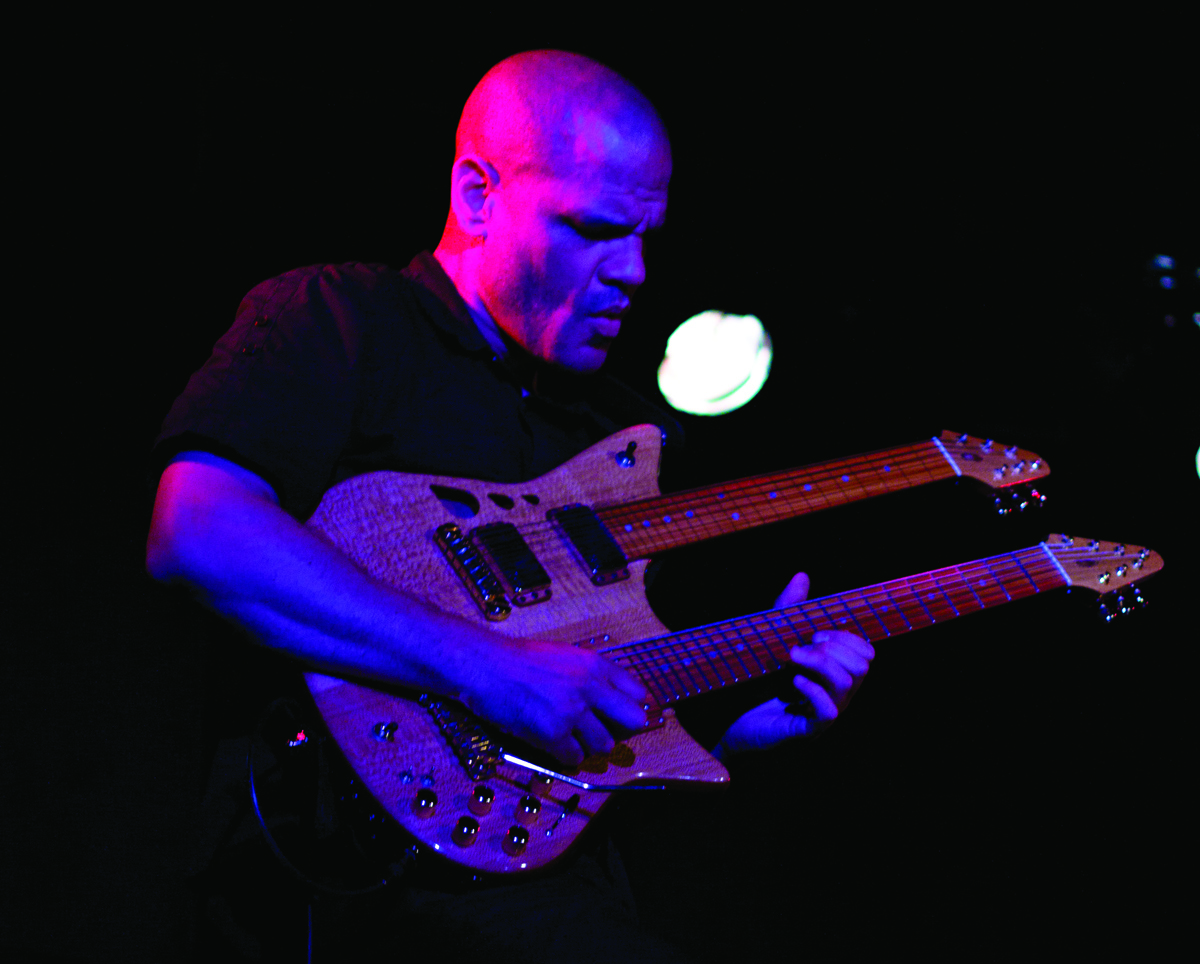Faculty Profile: David Fiuczynski

David Fiuczynski
Simon Yu
A Guggenheim for a Microtonalist
In New York music circles, Berklee Guitar Professor David Fiuczynski is known as the talented sideman for jazz greats like Jack DeJohnette, Christian McBride, and Branford Marsalis; the artistically adventurous guitarist with Meshell Ndegeocello; and partner to groove master John Medeski on the critically-acclaimed Lunar Crush CD. But left to his own devices, Dave "Fuze" Fiuczynski has an artistic vision that resides beyond the mainstream, blending microtonality with deep grooves. That vision has brought him an audience of devoted listeners, the praise of critics, and a Guggenheim composition fellowship.
Born in Newark, NJ, and raised in Mönchengladbach, Germany, Fiuczynski says his eclecticism may have been predestined. "My mother is African American and my dad is German, and I was always interested in mixing things," he says. "In high school, I would put on two records at the same time to see if the groove from one record would work with the melody from the other."
Fiuczynski elected to attend college in the United States. After a brief stint at a liberal-arts college, he transferred to New England Conservatory to pursue his passion for music. "When I started at NEC, most other students could play circles around me, but they didn't always know what they wanted to say. I was the opposite. I had a clear sense of what I wanted, but I didn't have the skills to realize it. I didn't know what a diminished scale was or how to improvise with it."
But in a class at NEC taught by the late Joe Maneri, Fiuczynski initially encountered microtonal music. "My first reaction was, 'Stop! This is awful.' But it all changed when I heard a good piece."
Interested, Fiuczynski began exploring non-Western musical traditions that used microtonalities. "They're like Eastern blue notes," he says. "They're expressive and colorful, and what makes them so powerful is that they're always inflected." He explains how points of inflection serve as places for an artist to express himself within the structure of the music. "When you start a blues, everybody knows it's going to be a blues, so the challenge becomes to use that common vocabulary in an expressive way," he says. "It's the same with a Hosseini maqam (a form of Turkish melody). Hosseini maqam has this poignant note somewhere between the sharp nine and natural nine. The question then becomes, How flat can you make that note and still retain its character? Finding out how far you can push it says a lot about you as an artist."
Some of the distinctions in microtonal music can be extremely fine. Fiuczynski explains how he uses these nuanced notes to his advantage. "Sometimes there's no significant melodic difference between notes, but the distinction becomes real when you use them harmonically. For example, when I fret a major-third dyad on the guitar, there's a beat pattern in the harmony. But if I play that same chord using harmonics, it becomes a pure interval with a very different sound."
Fiuczynski, who joined the Berklee faculty in 2001, believes that musicality always trumps the academic approach to composing. "A lot of microtonal cats can be so cerebral, and that's not me," he says. "Ultimately, I don't care if it's atonal, 12-tonal, or microtonal. I just want it to be good."
While many musicians have explored the materials in which Fiuczynski is interested, no one has combined them in quite the same way. "I don't want to become a master of Indian ragas or Turkish maqams," he says. "I want to explore these traditions for things I can use in my own music. Where I differ from Western avant-garde cats is that I like the groove. And where I differ from 'world' jazz players is that I like harmony. There's very little harmony in non-Western music, and I like to take interesting melodic notes from other systems and stack them into harmonies. It creates new kinds of chords you can't find on a piano."
Fiuczynski's iconoclastic experimentation has received critical acclaim and support from the Massachusetts Cultural Council, and most recently the John Simon Guggenheim Memorial Foundation. As a 2011 Guggenheim Fellow, Fiuczynski is working on a composition in which he aims to synthesize microtonal musical materials; grooves in the style of J Dilla, a hip-hop record producer; and a pan-Asian melodic tradition.
"All of the musical motifs are drawn from bird songs," says Fiuczynski. "I combed through about 7,000 bird calls on xeno-canto, a bird-song website. I'm not going to say that when you've heard one cuckoo, you've heard them all, but after about 10, you get the idea." From the bird songs, he created a vocabulary of scales and microtonal chords and hopes to have his students learn to use this vocabulary creatively and fluently. "My students have an opportunity to do something that's never been done, even before they leave Berklee," he says.
As a unifying principle, Fiuczynski has focused on the flam, a note preceded by a quick grace note. "A lot of birds flam, and there are all these expressive grace notes in East Asian music," Fiuczynski says. "J Dilla-style beats are full of flams. They create opportunities for melodic and rhythmic inflection, which makes the music come alive."
For all his compositional rigor, Fiuczynski focuses primarily on artistry. "The piece has to stand by itself. It can't come with an instruction manual. I want people to have a good time, and maybe think about something they've never heard before."
Given his track record, Fiuczynski is likely to find just the expressive blend he's looking for.
Writer and musician Adam Renn Olenn is the Web producer for Berklee's Office of Institutional Advancement.



